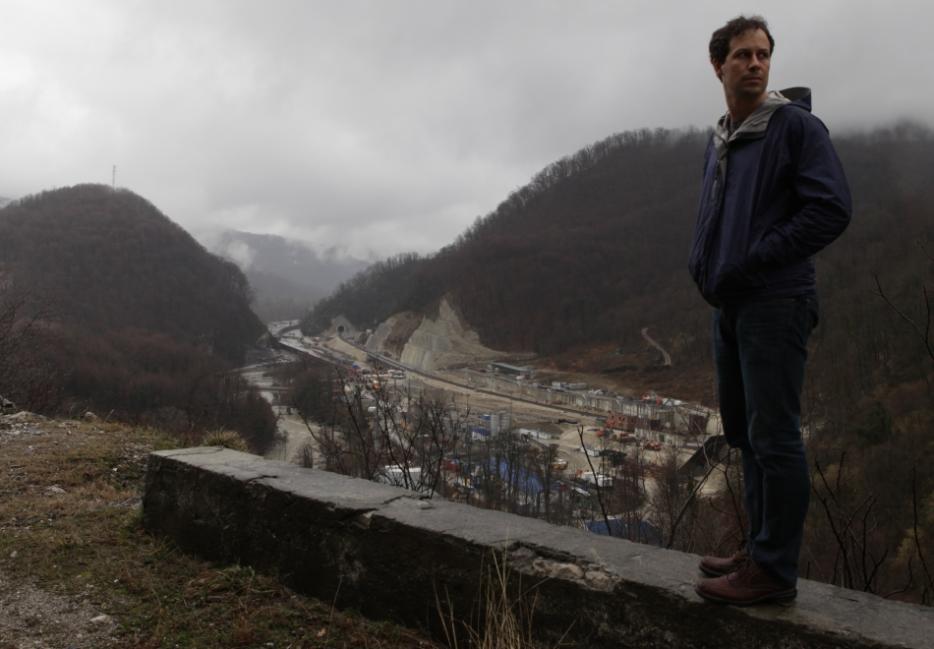When I arrived in Greenland, the secessionists had gathered in a community sports hall halfway up the island’s west coast. Upernavik was a town of eleven hundred people at a latitude of seventy-three degrees on a treeless tundra six hundred miles north of the capital, Nuuk. From Devon Island, where I’d sat at the observation post with the Vandoos, it was about five hundred miles due east, across Baffin Bay. But Danish-developed Upernavik stood in great contrast with the emptiness of Devon. The town had a fish plant, a hillside cemetery with concrete graves that were covered with plastic flowers, a single paved street, and an unmarked liquor store in a converted shipping container. Its wooden houses were painted in beautiful primary colors. Its teenagers hung out in the streets, blasting hip-hop from their cell phones, and in the mornings those streets were lined with yellow bags of excrement waiting to be picked up by sanitation teams. Upernavik was, like the rest of Greenland, oddly, lopsidedly modern—Scandinavian by design but not always by disposition.
Greenland had been a colony of Denmark for three centuries, and now it was on the verge of an oil and mineral boom that could help it become something else: the first country in the world created by global warming. I’d come here to join the secessionists’ road show—and to witness the moment that some of the supposed victims of climate change began cashing in on it. Greenland’s was an extreme case of the dilemma facing many citizens of the developed world, many northerners: If climate change wouldn’t much hurt them personally—if it might even help—why not embrace it?
The road show was led by the Office of Self-Governance, and it consisted of half a dozen Greenlandic politicians—men and women wearing jeans, fleece, and tennis shoes—and dozens of town-hall meetings. In the run-up to a referendum in November 2008, they were trying to reach nearly all of Greenland: fifty-seven thousand people spread out in fifty-seven villages and eighteen towns across an area of 836,000 square miles, three times the size of Texas and fifty times the size of mainland Denmark. There are almost no roads connecting the island’s settlements; it has two stoplights, both in fifteen-thousand-person Nuuk. We traveled by prop plane, helicopter, motorboat, and foot.
In the sports hall, one of the politicians warmed up the crowd with a funny story about a whale. He’d been a policeman here in the 1990s. The story went like this: The police chief gets a call from a citizen. The citizen is a fisherman. He’s caught a whale. He doesn’t know what he should do with this whale. The chief says to the citizen, “Put it in the boat. We’ll take care of it tomorrow.”
Put it in the boat! Take care of it tomorrow! The crowd, roughly sixty people, roared with laughter. Mininnguaq Kleist, the thirty-five-year-old head of the Office of Self-Governance and its principal PowerPoint presenter, doubled over. I pretended to laugh, too, but I had no idea what it meant.
When it was Minik’s turn to speak, he paced in front of his slide show wearing a headset, looking more like a televangelist than a revolutionary. Townspeople were sitting in red chairs below the basketball hoop, and out the window, in the bay near the fish plant, was an iceberg. Up for vote in a few months, Minik explained, was not full independence but a sort of half step, which was being called “self-governance”—“Namminersorneq” in Greenlandic, “Selvstyre” in Danish. Denmark, which gives Greenland nearly $650 million a year in subsidies—more than $10,000 a person—had signed off on it.
Greenlandic would become the official language if the referendum passed; Greenlanders would be recognized as a distinct people under international law. “We will take over policing,” Minik said, “and immigration, education, and the courts.” In the waters off Greenland’s northern coast, the U.S. Geological Survey had just identified the nineteenth richest of the world’s five hundred known petroleum provinces: an untapped Gulf of Mexico in the North Atlantic. To our south, near Disko Bay, Greenland’s first oil leases had just been sold to the likes of Chevron and ExxonMobil. Shell and partners would soon claim a lease a hundred miles from Upernavik, in Baffin Bay. Onshore, glaciers were pulling back to reveal massive deposits of zinc, gold, diamonds, and uranium. “Control of mineral and oil resources will also be taken over by Greenland,” Minik said.
They planned to drill themselves free. Under the agreement, the island would split mineral revenues with Denmark after keeping the first $15 million. As revenues went up, the $650 million annual grant from Denmark would go down. Eventually, over five years or ten, over fifteen years or twenty, if it warmed enough, if they drilled enough, the grant would hit zero, and Greenland would declare independence. In chemistry, there is activation energy: Add heat, get a reaction. In Greenland, there was global warming: Add heat, get a revolution. But this was secession at the speed of climate change, a slow burn.
When Minik was done, the mayor of Upernavik, a thin man with a few missing teeth, stood to pose a question. “Some of the money goes back to Denmark?” he asked, surprised. An old woman in a black sweater was next: “If we earn all that money, how much of it will stay in Greenland?”
Greenland had been a colony of Denmark for three centuries, and now it was on the verge of an oil and mineral boom that could help it become something else: the first country in the world created by global warming.
But the politicians were banking on more than mining. Valuable fish stocks—cod, herring, halibut, and haddock—were migrating into Greenlandic waters, moving north as the oceans warmed. There was a rush of disaster tourists, people coming to see the glaciers slide into the sea: Cruise ship arrivals had jumped 250 percent in four years, and shops sold postcards showing melting ice with the label “Climate Change and Global Warming.” The expansion of the South Greenland agricultural season—already three weeks longer than it was in the early 1990s—meant potato farms and carrot gardens and more grass for more sheep. There were plans for a new aluminum smelter—360,000 tons a year, the biggest in the world—to be built by Alcoa and run on hydropower from the island’s gushing rivers. A pair of ships had just finished laying high-speed Internet cable across the Denmark Strait, connecting Greenland to Iceland and onward to North America, and there were plans for fields of server farms—warehouses of computer processors working for Google or Cisco or Amazon—to take advantage of the cheap electricity and high latitude. “They normally need a lot of air-conditioning,” Minik explained. There were even plans for the melting ice itself: water exports. “The Greenland ice cap has an estimated volume of 1.7 million km3, the world’s biggest water reservoir,” boasted a Web site set up by the Secretariat of Ice and Water. Investors could sell “two million years of history in a bottle!”
*
It isn’t anyone in Greenland’s fault, but the Maldives are probably doomed. Tuvalu is probably doomed. Kiribati is probably doomed. The Marshall Islands are probably doomed. The Seychelles are probably doomed. The Bahamas are probably doomed. The Carterets are probably doomed. Bangladesh, at least a fifth of it, is probably doomed. Large portions of Manila, Alexandria, Lagos, Karachi, Kolkata, Jakarta, Dakar, Rio, Miami, and Ho Chi Minh City are probably doomed. Water enough to flood them all is stored in the world’s biggest reservoir, the Greenland ice cap, the frozen inland mass that covers 81 percent of the island. The rate of the ice cap’s melt had been increasing by 7 percent a year since 1996. If someday it melts entirely, global sea levels will jump more than twenty feet.
In Alaska, villages such as Newtok, Shishmaref, and Kivalina were also endangered, made increasingly unlivable by coastal erosion, melting permafrost, and creeping salinity. Newtok’s elders had acquired a new town site on a new island to their south—one with a hill—and were lobbying the state and federal government for the $130 million to move their 315 residents to it. The Shishmaref Erosion and Relocation Coalition had chosen a new site on the mainland, a few miles away, and was also awaiting funds. The residents of Kivalina were the plaintiffs in a conspiracy case against eight energy companies, including ConocoPhillips, ExxonMobil, and Chevron, who were accused of stirring up climate-change skepticism so they could produce more oil. The case—which would eventually be dismissed by a California judge—was being watched closely by American trial lawyers. As I heard one say excitedly at a conference, “This could really open up the floodgates . . . oh, probably not the right phrase.”
Small island nations also considered climate lawsuits—in 2002, Tuvalu had threatened to file one against Australia and the United States—but mostly they, too, were looking for someplace new: Seventy-five Tuvaluans and seventy-five Kiribatians a year go to New Zealand under immigration quotas; the first five of seventeen hundred Carteret Islanders moved to newly purchased land in Bougainville, also in Papua New Guinea, in 2009. In Australia, a Tuvaluan-born scientist named Don Kennedy was drumming up support to buy an island from Fiji for his people. In the Maldives, the charismatic president, Mohamed Nasheed, the “Obama of the Maldives” who became the face of climate change before he was forced out in a coup, declared that he was looking to buy land in Sri Lanka or Australia, just in case. This prompted an Indonesian minister to announce that his country had some spare islands to sell.
In the Alps, melting glaciers around the Matterhorn had shifted a border in place since 1861—it followed a ridge of snow that was no longer there—causing Italy and Switzerland to sit down and start negotiating a new one. In Kashmir, experts worried, the accelerating melt of the Siachen Glacier would further provoke the India-Pakistan fight. The shifting political map scared just about everyone. The NGO Christian Aid estimated that by 2050, a billion people would be pushed from their homes by global warming. Friends of the Earth said there would be as many as 100 million such climate refugees. The IPCC said 150 million. The Stern Review, 200 million. The International Committee of the Red Cross said there were 25 to 50 million already.
The implications of the melt were so bad for so much of the world that it seemed almost rude, even in Upernavik, to consider how good they were for Greenland. Since 2003, the ice cap had shrunk by more than a million tons, so much that the underlying bedrock rose four centimeters each year, like a ship slowly unweighted of its cargo. In Greenland, the land was rising faster than the sea.
Reprinted by arrangement with The Penguin Press, a member of Penguin Group (USA) LLC, A Penguin Random House Company. Copyright © McKenzie Funk, 2014.






